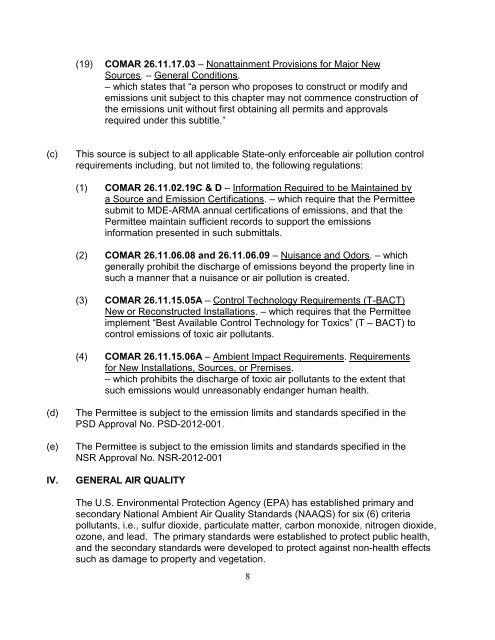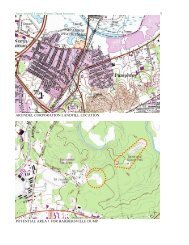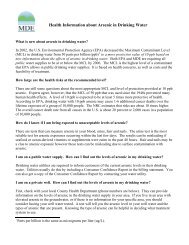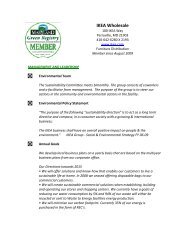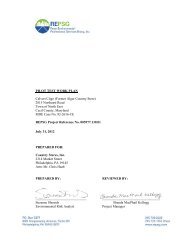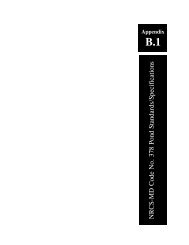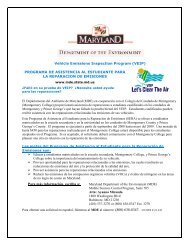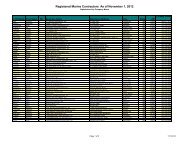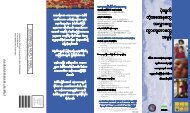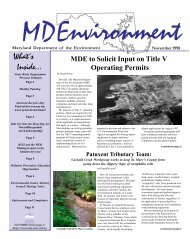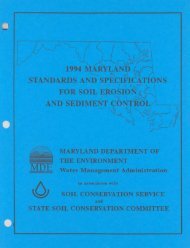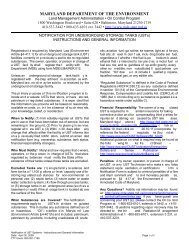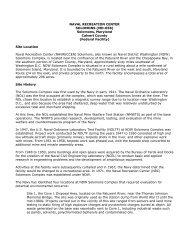fact sheet - Maryland Department of the Environment
fact sheet - Maryland Department of the Environment
fact sheet - Maryland Department of the Environment
You also want an ePaper? Increase the reach of your titles
YUMPU automatically turns print PDFs into web optimized ePapers that Google loves.
(19) COMAR 26.11.17.03 – Nonattainment Provisions for Major New<br />
Sources. – General Conditions.<br />
– which states that “a person who proposes to construct or modify and<br />
emissions unit subject to this chapter may not commence construction <strong>of</strong><br />
<strong>the</strong> emissions unit without first obtaining all permits and approvals<br />
required under this subtitle.”<br />
(c)<br />
This source is subject to all applicable State-only enforceable air pollution control<br />
requirements including, but not limited to, <strong>the</strong> following regulations:<br />
(1) COMAR 26.11.02.19C & D – Information Required to be Maintained by<br />
a Source and Emission Certifications. – which require that <strong>the</strong> Permittee<br />
submit to MDE-ARMA annual certifications <strong>of</strong> emissions, and that <strong>the</strong><br />
Permittee maintain sufficient records to support <strong>the</strong> emissions<br />
information presented in such submittals.<br />
(2) COMAR 26.11.06.08 and 26.11.06.09 – Nuisance and Odors. – which<br />
generally prohibit <strong>the</strong> discharge <strong>of</strong> emissions beyond <strong>the</strong> property line in<br />
such a manner that a nuisance or air pollution is created.<br />
(3) COMAR 26.11.15.05A – Control Technology Requirements (T-BACT)<br />
New or Reconstructed Installations. – which requires that <strong>the</strong> Permittee<br />
implement “Best Available Control Technology for Toxics” (T – BACT) to<br />
control emissions <strong>of</strong> toxic air pollutants.<br />
(4) COMAR 26.11.15.06A – Ambient Impact Requirements. Requirements<br />
for New Installations, Sources, or Premises.<br />
– which prohibits <strong>the</strong> discharge <strong>of</strong> toxic air pollutants to <strong>the</strong> extent that<br />
such emissions would unreasonably endanger human health.<br />
(d)<br />
(e)<br />
IV.<br />
The Permittee is subject to <strong>the</strong> emission limits and standards specified in <strong>the</strong><br />
PSD Approval No. PSD-2012-001.<br />
The Permittee is subject to <strong>the</strong> emission limits and standards specified in <strong>the</strong><br />
NSR Approval No. NSR-2012-001<br />
GENERAL AIR QUALITY<br />
The U.S. <strong>Environment</strong>al Protection Agency (EPA) has established primary and<br />
secondary National Ambient Air Quality Standards (NAAQS) for six (6) criteria<br />
pollutants, i.e., sulfur dioxide, particulate matter, carbon monoxide, nitrogen dioxide,<br />
ozone, and lead. The primary standards were established to protect public health,<br />
and <strong>the</strong> secondary standards were developed to protect against non-health effects<br />
such as damage to property and vegetation.<br />
8


